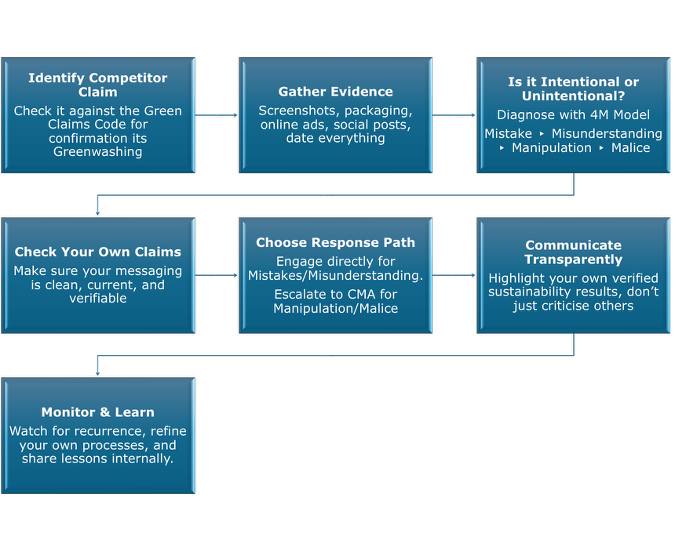
Greenwashing is one of today’s most urgent business challenges. For UK manufacturers, it’s not only ethical, it’s competitive.
It’s not just about environmental claims anymore; the full scope of sustainability is affected. When companies make false or misleading statements about environmental or ethical benefits, they are “sustainability washing.”
Competitors that exaggerate sustainability credentials can unfairly win contracts, attract customers, and damage sector trust. But new data, regulation, and consumer awareness make this the perfect time to turn risk into opportunity.
The scale of the issue: Greenwashing in numbers
The UK Advertising Standards Authority (ASA) found around 40% of online green claims misleading, often due to vague language, missing context, or weak evidence rather than deliberate fraud.
In my book Sustainability Washing, I identify four forms of it, the 4M model: Mistakes, Misunderstanding, Manipulation, and Malice. Research suggests:
- 50% of sustainability washing is intentional
- 50% is unintentional
Breakdown by type:
- Mistakes (25%) – errors, outdated data, sloppy language
- Misunderstanding (25%) – confusion over definitions or supplier reliance
- Manipulation (40%) – cherry-picking data, selective reporting
- Malice (10%) – deliberate deception
Even unintentional washing erodes trust and exposes businesses to ASA or CMA scrutiny.
Five facts UK manufacturers need to know:
1. ASA can censure, but not fine.
The ASA can block misleading ads but cannot issue financial penalties, so repeat offenders may persist until challenged again.
2. CMA now has teeth.
From April 2025, the Competition & Markets Authority (CMA) can fine firms up to 10% of global turnover for misleading environmental claims—without going to court.
3. Consumers are paying attention.
- 54% of UK consumers would stop buying from brands caught greenwashing; 18% already have.
- 61% distrust carbon footprint claims.
- 57% believe companies hide their environmental impact.
4. Trust in business leaders is falling.
- CEO trust is down 21% since 2021.
- 68% believe business leaders deliberately mislead.
5. Employer trust remains strong.
- 79% of employees trust their employer; 69% trust their CEO.
- For manufacturers, this is a major opportunity to build credibility locally and lead by example.
What to do if a competitor is greenwashing
Use the ASA/CMA Green Claims Code to assess any sustainability claims:
- Is it clear, specific, and understandable?
- Is it factually accurate and not exaggerated?
- Is there robust, current evidence?
- Does it cover the full product life cycle?
- Are limitations clearly stated?
- Does it refer to the entire product, not just one aspect?
- Are comparisons fair and relevant?
- Is durability or recyclability properly explained?
- Is more information easily accessible (QR code, website)?
- Does it go beyond legal compliance?
See full guidance: UK Government Green Claims Code.
Once a competitor’s sustainability washing is confirmed, follow an evidence-based response.
Step 1: Diagnose the type of greenwash
Apply the 4M model:
- Mistake / misunderstanding: Engage privately; fixes are often quick.
- Manipulation / malice: Escalate via your trade body or, if needed, ASA/CMA.
Step 2: Get your own house in order
- Audit claims against the Green Claims Code.
- Substantiate every statement.
- Use third-party validation (Made in Britain ESV, PAS 2060, ISO 14021).
Step 3: Choose your escalation route
- Direct: Contact the competitor constructively.
- Industry: Raise the issue through trade associations.
- Regulatory: File a complaint with ASA or CMA for serious/repeated cases.
Step 4: Tell your story better
Turn competitor greenwashing into differentiation:
- Share verified impact data.
- Use case studies to show results.
- Highlight employees and customers to build credibility.
Step 5: Build long-term advantage
Don’t just react—lead improvement:
- Educate customers on credible claims.
- Collaborate on industry standards.
- Embed sustainability in procurement, design, and operations.
Quick-reference flowchart
A simple step-by-step guide to follow when competitor sustainability washing is spotted.
Turning threat into opportunity
Competitor greenwashing can frustrate, but also inspire positive change. By staying evidence-based, responding proportionately, and communicating transparently, you can:
- Protect your competitive position (use the Green Claims checklist before all communications).
- Strengthen trust with customers and employees.
- Avoid regulatory risk.
- Lead your sector to higher standards.
In a market where 40% of green claims mislead and trust is fragile, success belongs to those who can prove, sustain, and communicate real impact.
Professor Chris Harrop OBE is visiting professor in sustainable business at the University of Huddersfield Business School.
By Made in Britain 1 day ago | By Made in Britain